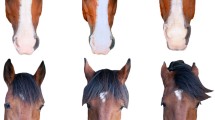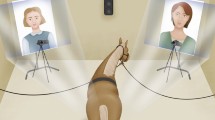Abstract
The human–horse relationship has a long evolutionary history. Horses continue to play a pivotal role in the lives of humans and it is common for humans to think their horses recognize them by face. If a horse can distinguish his/her human companion from other humans, then evolution has supplied the horse with a very adaptive cognitive ability. The current study used operant conditioning trials to examine whether horses could discriminate photographed human faces and transfer this facial recognition ability a novel setting. The results indicated the horses (a) learned to discriminate photographs of the unrelated individuals, fraternal twins, and identical twins and (b) demonstrated transfer of facial recognition by spending more time with their S+ woman in the field test.




Similar content being viewed by others
References
Alexander G, Shillito EE (1977) Importance of visual clues from various body regions in maternal recognition of the young in merino sheep (Ovis aries). Appl Anim Ethol 3:137–143
Boissy A, Bouissou MF (1988) Effects of early handling on heifers’ subsequent reactivity to humans to unfamiliar situations. Appl Anim Behav Sci 20:259–273
Boivin X, Le Neindre P, Garel JP, Chupin JM (1994) Influence of breed and rearing management on cattle reactions during human handling. Appl Anim Behav Sci 39:115–122
Boivin X, Garel JP, Mante A, Le Neindre P (1998) Beef calves react differently to different handlers according to the test situation and their previous interactions with their caretaker. Appl Anim Behav Sci 55:245–258
Boysen ST, Berntson GG (1986) Cardiac correlates of individual recognition in the chimpanzee (Pan troglodytes). J Comp Psychol 100:321–324
Brown SD, Dooling RJ (1993) Perception of conspecific faces by budgerigars (Melopsittacus undulates). II. Synthetic models. J Comp Psychol 107:48–60
Budiansky S (1997) The nature of horses. Free Press, New York, NY
de Passille AM, Rushen J, Ladewig J, Petherick C (1996) Dairy 500 calves’ discrimination of people based on previous handling. J Anim Sci 74:969–974
DePauw K (1992) Review of research in therapeutic riding. In: Engel B (ed) Therapeutic 503 riding programs: instruction and rehabilitation. B. Engel Therapy Services, Durango, CO
Diamond J (1992) The third chimpanzee: the evolution and future of the human animal. Harper Perennial Publishers, New York, NY
Engel BT (1994) Bibliography of the federation of riding for the disabled international. B. Engel Therapy Services, Durango, CO
Fell LR, Shutt DA (1989) Behavioural and hormonal responses to acute surgical stress in sheep. Appl Anim Behav Sci 22:283–294
Fitzpatrick JC, Tebay JM (1996) Hippotherapy and therapeutic riding. In: Wilson CC, Turner DC (eds) Companion animals in human health. Sage Productions, Thousand Oaks, CA
Grzimek B (1944) Recognition of human beings by horses. Z Tierpsychol 519(6):110–126
Grzimek B (1952) The colour vision of horses. Z Tierpsychol 9:23–29
Hanggi EB (1997) The learning to learn phenomenon. Savvy: The International Journal of Parelli Natural Horsemanship 2:38–43
Hanggi EB (1999) Categorization learning in horses (Equus caballus). J Comp Psychol 113:243–252
Hanggi EB, Ingersoll JF, Waggoner TL (2007) Color vision in horses (Equus caballus): deficiencies identified using a pseudoisochromatic plate test. J Comp Psychol 121(1):65–72
Hemsworth PH, Coleman GJ, Cox M, Barnett JL (1994) Stimulus generalization: the inability of pigs to discriminate between humans on the basis of the previous handling experience. Appl Anim Behav Sci 40:129–142
Hemsworth PH, Price EO, Borgwardt R (1996a) Behavioural responses of domestic pigs and cattle to humans and novel stimuli. Appl Anim Behav Sci 50:43–56
Hemsworth PH, Verge J, Coleman GJ (1996b) Conditioned approach-avoidance responses to humans: the ability of pigs to associate feeding and aversive social experiences in the presence of humans with humans. Appl Anim Behav Sci 50:71–82
Herrnstein RJ, Loveland DH, Cable C (1976) Natural concepts in pigeons. J Exp Psychol: Anim Behav Proc 2(4):285–302
Jones RB (1994) Regular handling and the domestic chick’s fear of human beings: generalization of a response. Appl Anim Behav Sci 42:129–143
Kendrick KM (1991) How the sheep’s brain controls the visual recognition of animals and humans. J Anim Sci 69:5008–5016
Kendrick KM, Baldwin BA (1989) Visual responses of sheep temporal cortex cells to moving and stationary human images. Neurosci Lett 100:193–197
Kendrick KM, Atkins K, Hinton MR, Broad KD, Febre-Nys C, Keverne B (1995) Facial and vocal discrimination in sheep. Anim Behav 49:1665–1676
Kendrick KM, Atkins K, Hinton MR, Heavens P, Keverne B (1996) Are faces special for sheep? Evidence from facial and object discrimination learning tests showing effects of inversion and social familiarity. Behav Proc 38:19–35
Kendrick KM, da Costa AP, Leigh AE, Hinton MR, Peirce JW (2001) Sheep don’t forget a face. Nature 414:165–166
Koda Y, Tanida H (2001) How do miniature pigs discriminate between people? Discrimination between people wearing coveralls of the same colour. Appl Anim Behav Sci 73:45–58
Krueger K, Heinze J (2008) Horse sense: social status of horses (Equus caballus) affects their likelihood of copying other horses’ behavior. Anim Cogn 11(3):431–439
Mader DR, Price EO (1980) Discrimination learning in horses: effects of breed, age, and social dominance. J Anim Sci 50:962–965
Martin-Malivel J, Fagot J (2001) Perception of pictorial human faces by baboons: effects of stimulus orientation on discrimination performance. Anim Learn Behav 29:10–20
McCall RB, Lester ML, Corter CM (1969) Caretaker effect in rats. Develop Psychol 1:771
Munksgaard L, de Passille AM, Rushen J, Thodberg K, Jensen MB (1997) Discrimination of people by dairy cows based on handling. J Dairy Sci 80:1106–1112
Munksgaard L, de Passille AM, Rushen J, Ladewig J (1999) Dairy cows’ use of colour cues to discriminate between people. Appl Anim Behav Sci 65:1–11
Netting FE, Wilson CC, New JC (1987) The human–animal bond: implications for practice. Social Work 32:60–64
Parr LA, de Waal FBM (1999) Visual kin recognition in chimpanzees. Nature 399:647
Parr LA, Winslow JT, Hopkins WD, de Waal FBM (2000) Recognizing facial cues: individual discrimination by chimpanzees (Pan troglodytes) and rhesus monkeys (Macaca mulatta). J Comp Psychol 114:47–60
Pascalis O, Petit O, Kim JH, Campbell R (1999) Picture perception in primates: the case of face perception. Curr Psychol Cogn 18:889–921
Podberscek AL, Blackshaw JK, Beattie AW (1991) The behaviour of laboratory colony cats and their reactions to a familiar and unfamiliar person. Appl Anim Behav Sci 31:119–130
Rosenfield SA, Van Hoesen GW (1979) Face recognition in the rhesus monkey. Neuropsychol 17(5):503–509
Rubin L, Oppegard C, Hintz HF (1980) The effect of varying the temporal distribution of conditioning trials on equine learning behavior. J Anim Sci 50:1184–1187
Rybarczyk P, Koba Y, Rushen J, Tanida H, de Passille AM (2001) Can cows discriminate people by their faces? Appl Anim Behav Sci 74:175–189
Sappington BF, Goldman L (1994) Discrimination learning and concept formation in the Arabian horse. J Anim Sci 72:3080–3087
Schusterman RJ, Gisiner R, Hanggi EB (1992) Imprinting and other aspects of pinniped-human interactions. In: Davis H, Balfour D (eds) The inevitable bond: examining scientist–animal interactions. Cambridge University Press, New York, NY, pp 334–356
Settle RH, Sommerville BA, McCormick J, Broom DM (1994) Human scent matching using specially trained dogs. Anim Behav 48:1443–1448
Slobodchikoff CN, Kiriazis J, Fischer C, Creef E (1991) Semantic information distinguishing individual predators in the alarm calls of Gunnison’s prairie dogs. Anim Behav 42:713–719
Tanida H, Miura A, Tanaka T, Yoshimoto T (1995) Behavioural response to humans in individually handled weanling pigs. Appl Anim Behav Sci 42:249–260
Taylor AA, Davis H (1997) Individual humans as discriminative stimuli for cattle (Bos Taurus). Appl Anim Behav Sci 58:13–21
Timney B, Keil K (1992) Visual acuity in the horse. Vision Res 32:2289–2293
Timney B, Keil K (1996) Horses are sensitive to pictorial depth cues. Perception 25:1121–1128
Waring GH (1983) Horse behavior. Noyes Publications, Park Ridge, NJ
Wilson CC, Turner DC (eds) (1998) Companion animals in human health. Sage Publications, Thousand Oaks, CA
Acknowledgments
The author thanks the student workers and research assistants for their dedicated work on these projects. Special thanks go to Rachel Clay and Jessica Clay for their assistance. In addition, this research would not have been possible without Ahna Hoff, Nikki Yonts, Brooke and Brittany Morgan, and Laura and Christy Land and their valuable contribution is greatly appreciated. The author also thanks the reviewers for the detailed suggestions and comments which improved the readability of this paper.
Author information
Authors and Affiliations
Corresponding author
Rights and permissions
About this article
Cite this article
Stone, S.M. Human facial discrimination in horses: can they tell us apart?. Anim Cogn 13, 51–61 (2010). https://doi.org/10.1007/s10071-009-0244-x
Received:
Revised:
Accepted:
Published:
Issue Date:
DOI: https://doi.org/10.1007/s10071-009-0244-x




